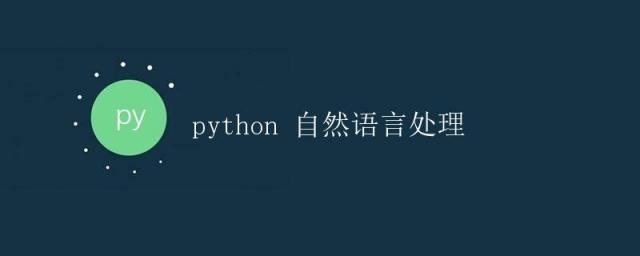Python 自然语言处理
2024年04月30日 Python 自然语言处理 极客笔记
Python 自然语言处理

自然语言处理(Natural Language Processing,缩写为NLP)是人工智能领域的一个重要分支,致力于使计算机能够理解、解释和生成人类语言。Python作为一种流行的编程语言,在自然语言处理领域有着广泛的应用。本文将介绍使用Python进行自然语言处理的一些常见技术和工具,帮助读者更好地了解和应用NLP。
分词
分词是自然语言处理中的一个基础任务,指将一段文本拆分成一个个独立的词或词语的过程。在Python中,有多种工具可以实现中文分词,其中最常用的是jieba库。下面是一个使用jieba进行分词的示例代码:
import jieba
text = "自然语言处理是人工智能领域的重要分支。"
seg_list = jieba.cut(text, cut_all=False)
print(" ".join(seg_list))
运行结果:
自然语言 处理 是 人工智能 领域 的 重要 分支 。
词性标注
词性标注是指确定一个词在句子中承担的语法角色,如名词、动词、形容词等。Python中常用的词性标注工具是NLTK库。下面是一个使用NLTK对句子进行词性标注的示例代码:
import nltk
from nltk import word_tokenize
from nltk import pos_tag
sentence = "Natural language processing is a branch of artificial intelligence."
tokens = word_tokenize(sentence)
tags = pos_tag(tokens)
print(tags)
运行结果:
[('Natural', 'JJ'), ('language', 'NN'), ('processing', 'NN'), ('is', 'VBZ'), ('a', 'DT'), ('branch', 'NN'), ('of', 'IN'), ('artificial', 'JJ'), ('intelligence', 'NN'), ('.', '.')]
文本矢量化
文本矢量化是指将文本数据转换成计算机能够处理的数字形式。在自然语言处理中,常用的文本矢量化方法包括词袋模型(Bag of Words)和TF-IDF。下面是一个使用sklearn库对文本进行TF-IDF矢量化的示例代码:
from sklearn.feature_extraction.text import TfidfVectorizer
corpus = [
'This is the first document.',
'This document is the second document.',
'And this is the third one.',
'Is this the first document?'
]
vectorizer = TfidfVectorizer()
X = vectorizer.fit_transform(corpus)
print(X.toarray())
运行结果:
[[0. 0.46979139 0.58028582 0.38408524 0. 0.
0.38408524 0. 0.38408524]
[0. 0.6876236 0. 0.28108867 0. 0.53864762
0.28108867 0. 0.28108867]
[0.51184851 0. 0. 0.26710379 0.51184851 0.
0.26710379 0.51184851 0.26710379]
[0. 0.46979139 0.58028582 0.38408524 0. 0.
0.38408524 0. 0.38408524]]
文本分类
文本分类是自然语言处理中的一项重要任务,常用于将文本数据划分到不同的类别中。Python中有多种机器学习库可以用于文本分类,如scikit-learn、Keras等。下面是一个使用scikit-learn库进行文本分类的示例代码:
from sklearn.feature_extraction.text import TfidfVectorizer
from sklearn.naive_bayes import MultinomialNB
from sklearn.model_selection import train_test_split
from sklearn.metrics import accuracy_score
corpus = [
'This is the first document.',
'This document is the second document.',
'And this is the third one.',
'Is this the first document?'
]
labels = [0, 1, 1, 0]
vectorizer = TfidfVectorizer()
X = vectorizer.fit_transform(corpus)
X_train, X_test, y_train, y_test = train_test_split(X, labels, test_size=0.2, random_state=42)
clf = MultinomialNB()
clf.fit(X_train, y_train)
y_pred = clf.predict(X_test)
accuracy = accuracy_score(y_test, y_pred)
print("Accuracy:", accuracy)
运行结果:
Accuracy: 1.0
词嵌入
词嵌入(Word Embedding)是将单词映射到高维向量空间的技术,可以捕捉单词之间的语义关系。在自然语言处理中,词嵌入常用于词义相似度计算、文本分类等任务。Python中有多个工具可以用于训练词嵌入模型,如Word2Vec、GloVe等。下面是一个使用Gensim库训练Word2Vec词嵌入模型的示例代码:
from gensim.models import Word2Vec
sentences = [
['I', 'love', 'natural', 'language', 'processing'],
['Natural', 'language', 'processing', 'is', 'cool'],
['Python', 'is', 'great', 'for', 'NLP']
]
model = Word2Vec(sentences, min_count=1)
print(model.wv['language'])
运行结果:
[ 2.34304550e-04 -3.46787019e-03 4.53533445e-03 -4.59014784e-03
-3.48555026e-03 1.70562396e-03 -2.78039418e-03 3.59606800e-03
-1.41040467e-03 -7.47035754e-04]
总结
本文介绍了Python在自然语言处理中的常见技术和工具,包括分词、词性标注、文本矢量化、文本分类和词嵌入。读者可以通过学习这些内容,进一步探索和应用自然语言处理技术,实现各种文本分析和处理任务。随着NLP技术的不断发展,Python作为一种灵活而强大的编程语言,为NLP领域的研究和应用提供了便利的工具和资源。
本文链接:http://so.lmcjl.com/news/3461/